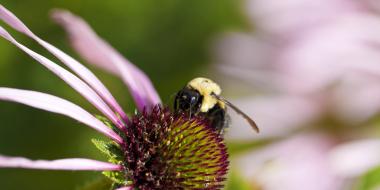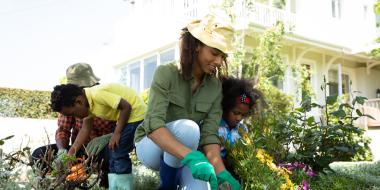It’s a special kind of thrilling to see the colourful array of ripe fruits at your local farmers’ market or to visit a U-pick orchard and partake of produce that’s fresh off the vine, tree, or bush. Because of space, time, and climate, you most likely won’t be able to start an orchard in your yard, but you can add a new dimension to your garden and get the experience of stepping out your door to grab a treat at the peak of its nutritional goodness by planting fruit trees!
Choosing the right cultivar
Do you want apples? Cherries? Pears? Once you figure that one out, you’ll need to choose a cultivar, or in simple terms, the variety of the particular fruit. A Macintosh apple is a different cultivar than a Northern Spy or a Mutsu apple. The type of cultivar will impact the flavour, shape, colour, size, storage life, and disease-resistance of the fruit. As a home-grower who wants success with little extra work, and no extra chemicals on or in your food, you definitely want to look for varieties that are not as susceptible to disease. Your local nursery will know best what type of fruit will thrive in your region and which ones are least prone to pests.
Best bets for the beginner fruit tree grower
There are so many to choose from! Naturally, you will be limited by your regional climate, geography, and soil type, but there will likely be something delicious and beautiful just waiting to take root in your yard! Here are a few fruits that are likely to thrive in many areas of North America.

Adorable Apple
Everyone loves apples! Do you want to eat them fresh? Bake with them? Dry them? Make sauce from them? Some cultivars are multi-purpose, while others are particularly good for specific preparations, like sauce. You need two different cultivars for cross-pollination to occur but if there are ornamental crab apples within pollinating distance, they will do the job just fine! If you’re tight on space, you can get trees with multiple varieties grafted on to one root stock so that you don’t need to plant two trees. Some good disease-resistant varieties are Liberty, Enterprise, Nova Easygro, Novamac, GoldRush, Crimson Crisp, and Redfree.

Charming Cherry
Cherries are a great early summer fruit to have in your yard. And if you happen to be away over harvest time, the birds will be more than happy to clean them up for you! Cherries come in sweet or sour forms. These will not cross-pollinate each other but there are several varieties that are self-fertile. Sour cherries are best for baking, but can also be eaten fresh, canned, and frozen. Cherries need well-drained soil so if you have heavy clay, go for a different fruit. Disease-resistant varieties include Kristin, North Star (both sweet) and Montmorency (sour).

Fabulous Fig
In southern climates, figs can grow outside all year. In colder areas you’ll have to bring them indoors to a basement or garage for the winter, and some years the fruits may not reach maturity before cold weather moves in. Figs will not ripen off the tree so wait until the fruit has turned colour and yields softly to the touch. Disease-resistant varieties include Texas Everbearing, Champagne, Alma, Violette de Bordeaux (also called Negronne), and LSU Purple. Be careful not to overwater as they are prone to fungal diseases. Figs will only keep for a couple of weeks in the refrigerator once picked so if you have too much abundance for fresh eating (fingers crossed!) you can dry, freeze or can them.
Grafting is the process by which a cutting or branch from a desirable tree is attached to the rootstock of a different tree.
Sizing up root stock
When you buy a tree from a garden centre it will often be in a pot. If you can find a nursery in your area that sells bare root trees, these are always the best option for the long-term health of the tree. Bare root trees are dug up while they're dormant and the earth is washed from the roots which are then packed in moist material. The advantage of these is that they can be less expensive, establish more quickly in the new soil, and a larger selection may be available if you’re ordering from a catalogue. Nurseries selling bare root stock will usually ship the trees to you in early spring or late fall and they will need to be planted within a few days of arrival. A bare root tree may be a little smaller than the potted ones but it won’t go into shock upon transplant and will rapidly catch up to and surpass its potted siblings with less need for water and external nutrients. You’ll also want to apply a mycorrhizal inoculant to the roots when you plant it so that good soil relationships are there from the start. Your tree will be able to access water and nutrients more easily when these great fungal partners are present.
Trees to grow from seed
Thinking about growing a fruit tree from seed? You can do that too! Keep in mind though: not all seeds are created equally. While almond-shaped pits like plum and nectarine may do well, other fruit trees like apples are typically started from a graft rather than seed because there is no guarantee that the apple seed you plant will result in a tree that bears the same juicy fruit as its parent. If you’ve decided to purchase a grafted fruit tree, make sure to know what type of root stock your tree is on—both to control height and disease. Common options are Dwarf, Semi-dwarf, or Standard root stock. There is also Super-Dwarf if you have a very small space to work with or are growing in containers. A fully-grown Standard tree could be 30 feet tall, while a Super-Dwarf may max out at four feet. Whether you have clay or sandy soil, or a wet or dry environment, you want to look for root stocks appropriate for those conditions. Certain root stocks are also bred to be disease-resistant.
Generating a guild
Consider the “neighbourhood” your tree will grow in by researching the kind of guild it could benefit from. A guild is a group of plants that will help to support your main tree. Include plants that fix nitrogen and other nutrients, like clover, lupins, and false indigo; attract pollinators, like yarrow, cone flower, and salvia; and repel pests, like lavender, oregano, and chives. Also consider some pretty spring bulbs to catch all the moisture and nutrients from spring snow melts. Plant these starting two to three feet from the trunk of your tree and spread out from there. If you’re not ready for a guild yet, aim to keep grass at least two feet from the trunk and lay wood mulch down around it instead. Don’t let the mulch pile up around the trunk as it will rot the bark—shape it like a donut around the tree to allow for water drainage.
Cross-pollination for some fruit trees is the only way to get the good stuff (aka fruit!). As bees and other insects flit back and forth among the fruit blossoms, they transfer pollen, resulting in fertilization, and the beginning of a seed. If you’re planning to grow apple, pear, cherry, or plum, you’ll probably need at least one other tree of a different variety in order to ensure fruiting success!
Go ahead and plant your little orchard of one, watch it grow, and before you know it, you’ll be enjoying the fruits of your labour!






